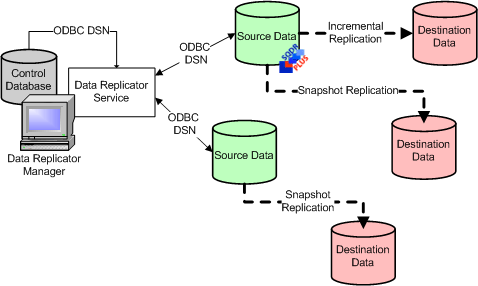
The main components of the base StarQuest Data Replicator product are the Replicator Manager application and the Replicator Service. You use the Replicator Manager application to define sources, destinations, and subscriptions. Sources and destinations define the source and target data; subscriptions describe the data to be replicated for a particular operation. The source, destination, and subscription definitions are stored in a control database, which the Replicator Service communicates with to run the replications.
Installing the Data Replicator installs both the Replicator Manager and the Service, as illustrated in the following diagram. Each Replicator Service requires one control database, which can be created by any of the editions of SQL Server or Db2 LUW that are listed in System Requirements. If you do not already have SQL Server installed, Installing SQL Server for a Control Database describes how to obtain a version of SQL Server that Microsoft provides free of charge.

Each Replicator Service typically manages multiple sources and destinations, which are defined as ODBC datasources (DSNs) or connection strings that connect to a specific type of database. The subscriptions that you specify using the Replicator Manager define what data is replicated, how it is replicated, and when it is replicated.
If SQDR Plus is installed and configured for the source, you also can define subscriptions that incrementally update the destination data, rather than performing a full refresh of the data. Subscriptions to a host that has the SQDR Plus Capture Agent configured can perform either snapshot replication or incremental replication operations, as depicted in the illustration above.
An installer containing only the Replicator Manager and related management applications can be installed on a Windows workstation for managing one or more remote Replicator Services. This is required when running the Replicator Service on Linux.
Configuring the Replicator Service